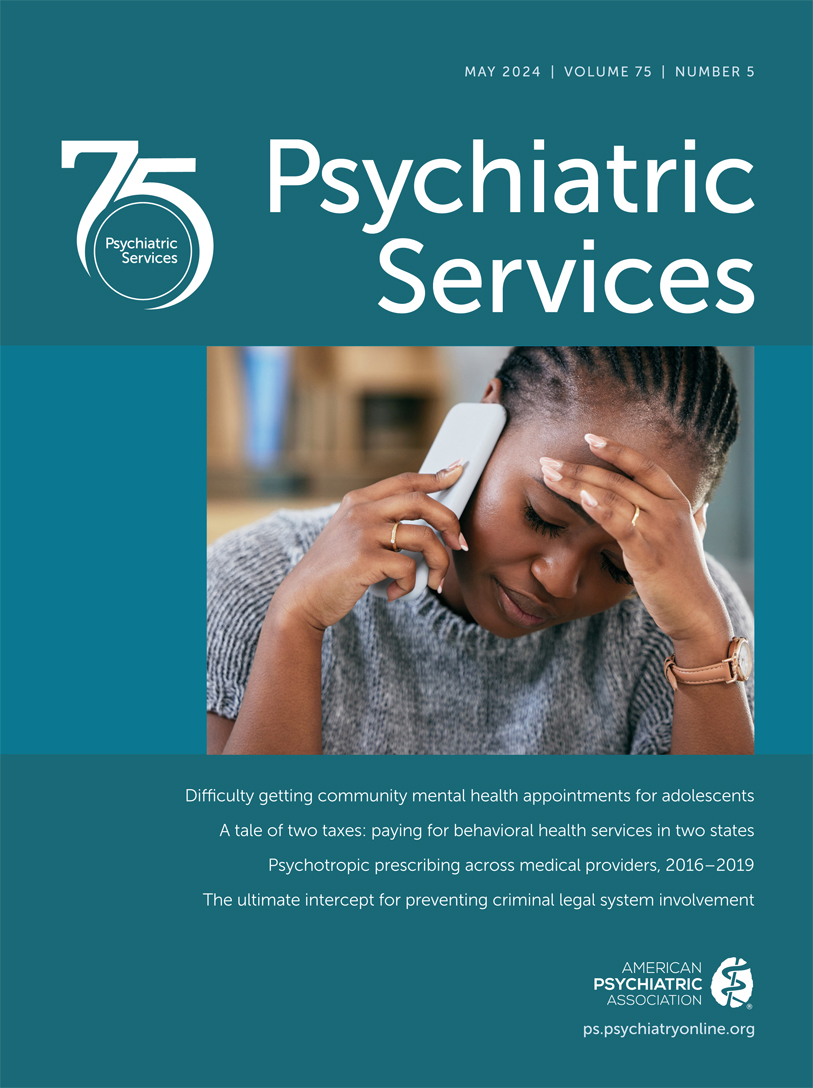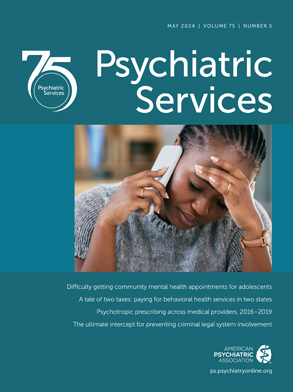The sequential intercept model (SIM) is a leading approach to finding community-based solutions to the overrepresentation of people with serious mental illnesses (i.e., schizophrenia and other psychotic disorders, bipolar disorder, and major depressive disorder) in the criminal legal system. The SIM identifies jail diversion opportunities to prevent individuals with serious mental illness from entering the criminal legal system and to connect them to community-based services (
1). Ideally, people at risk for criminal legal system involvement are diverted as early as possible, sometimes before contact with the criminal legal system. The crisis care continuum is a prearrest diversion opportunity (intercept 0 of the SIM), because alternative emergency responses to mental health crises can prevent contact with law enforcement (
2). Another opportunity for prearrest diversion includes specialized police responses (e.g., crisis intervention teams [CIT], intercept 1). Postarrest diversion opportunities include identifying mental health needs at booking or at an initial court hearing (intercept 2), connecting people in jail to services or specialized court dockets (intercept 3), facilitating reentry from jail or prison (intercept 4), and community corrections programs such as specialized probation or parole (intercept 5). The SIM’s “ultimate intercept” is the community-based mental health and substance use services system that prevents initial or repeated contact with the criminal legal system (
1).
Limitations and Unknowns of Jail Diversion
Despite a proliferation of jail diversion programs, people with serious mental illness continue to be overrepresented in the criminal legal system, even in communities with multiple jail diversion initiatives. This continued overrepresentation has led to the suggestion that a “saturation point of effectiveness” has been reached and that no new resources should be devoted to jail diversion and that instead social determinants of health and criminogenic risk factors should become a new focus (
3). We agree that addressing social determinants and criminogenic needs can reduce criminal legal system involvement but do not believe that a full potential in providing effective and comprehensive jail diversion alternatives has been reached. We advocate for continued funding and study of the development, implementation, and outcomes of jail diversion alternatives. We also endorse moving upstream to support the community mental health system’s role in preventing involvement of people with serious mental illness in the criminal legal system by addressing clinical, criminogenic, and social needs. In other words, the role of the ultimate intercept in jail diversion needs to be recognized and enhanced.
We do not agree with Wasser’s (
3) suggestion that a saturation point has been reached for jail diversion alternatives, because in our view, more work remains to be done to prevent criminal legal system involvement of individuals with serious mental illness. Although some diversion programs (e.g., CIT at intercept 1 and specialized mental health court dockets at intercept 3) have been implemented widely, full implementation of these programs takes time, and they often evolve. For example, a specialized police response such as CIT takes time to be fully implemented within a police agency and takes even more time to expand to multiple jurisdictions in a county. The CIT program may evolve by adding a co-response unit or by partnering with mobile crisis services. Similarly, a court may start a specialized docket and then add a forensic assertive community treatment team for individuals who do not meet eligibility criteria for or choose to opt out of participating in the specialized docket.
We also note that effective jail diversion interventions are challenging to sustain. Cross-system planning activities that map out opportunities to prevent criminal legal system involvement can foster collaboration (
4), but trust, mutual understanding, and procedures that undergird collaboration must be established and nurtured. Through these trusting relationships, the mental health system can influence how the criminal legal system processes individuals with mental illness. Unfortunately, cross-system partnerships often face limited funding and resources, competing demands on members’ time, and leadership turnover or other health crises, such as the opioid epidemic or COVID-19 pandemic, that emerge and divert attention and resources.
The Importance of a Comprehensive Mental Health System for Jail Diversion
Although strides have been made in implementing effective diversion alternatives across the criminal legal system, their success depends on a responsive, comprehensive mental health system (
5–
7). For example, the SIM has been expanded to the mental health crisis response continuum, and community stakeholders are identifying ways to divert individuals from the forensic mental health system to reduce the number of public psychiatric beds used for competency restoration (
8). Even in communities with long-standing programs or a robust array of approaches to reduce criminal legal system involvement, it is not clear that these programs are operating to their full potential. Little is known about the combined impact of complementary diversion programs. Such research examining multiple diversion alternatives across the criminal legal system is scarce but promising (
9).
Community factors can influence implementation and fidelity of interventions at the interface of the mental health and criminal legal systems (
10). Ideally, the service environment includes a comprehensive array of clinical services that are effective, accessible, criminologically informed, and culturally responsive (
11–
13). Further, because the clinical mental health and substance use services system cannot be expected to address all clients’ needs, coordination is required between this system and the social support services system. Diversion alternatives will not work if there is nowhere to divert people to, or no one to follow up or connect people in need to services.
Methodological challenges have hampered the ability to study efforts to reduce or prevent criminal legal system involvement for people with mental illness. As Wasser (
3) notes, jail diversion programming has had varying levels of success, the evidence base supporting jail diversion is limited, and findings are often nuanced. Although research has shown the efficacy of diversion programs, many barriers limit translation of this knowledge to program effectiveness across diverse settings. Not only is funding limited, but this research also faces many logistical and methodological challenges. It is difficult to retain people in community-based research studies because their clinical, social, and legal needs present obstacles to longitudinal research designs (
14). Likewise, it is challenging to follow up with individuals as they transition through the criminal legal system (
15). Local practices, embedded within state policy, make multisite comparisons difficult. Furthermore, it is difficult to determine whether a program that is focused on individual-level outcomes can affect outcomes at a broader systems level (
9). Assessing the effectiveness of jail diversion programming depends on an ability to analyze systems-level processes and outcomes related to multiple approaches to preventing criminal legal system involvement.
Finally, because of a great need for jail diversion, such programs are hastily implemented without knowing what works best and under what conditions. Decision makers then move on too quickly if it appears that the program is not working or when new challenges emerge. Today’s popular new jail diversion program may be abandoned before it is fully studied. High-quality research about jail diversion is needed, including implementation research, program evaluation, ongoing quality improvement as programs evolve, and individual- and systems-level outcomes studies with a goal of understanding what works for whom, under what circumstances.”
More work needs to be done before declaring that a saturation point on jail diversion has been reached. However, we agree with Wasser (
3) that additional resources are critically needed for addressing social determinants of mental health, criminogenic needs, and the impact of criminal legal system involvement among people with serious mental illness. Such resources could include support for programs such as Housing First and Social Security Disability Insurance Outreach, Access, and Recovery programs that connect people at increased risk for homelessness to disability income benefits. Access to recovery-oriented services (e.g., vocational, housing, and education) needs to be improved as originally intended in describing the ultimate intercept. This approach would necessitate increased funding for models such as certified community behavioral health clinics that improve service delivery, accessibility, and care coordination.
Jail diversion itself is an approach to addressing social determinants of health, with the potential to improve health and criminal legal outcomes. Diversion programs connect people to services, such as case management and social service programs, which facilitate access to financial support resources, stable and safe housing, or vocational or educational services. Effective diversion, in connecting a person in need to clinical care and social services, has the potential to influence how the criminal legal system serves this population, emphasizing recovery over punishment and giving substantial control to the community-based mental health services system.
The Ultimate Intercept: A Community-Based System for Prevention
To improve service delivery, the needs of the population receiving services at community mental health agencies require a better understanding. Although mental illness is not a significant criminogenic risk factor, criminal legal system involvement is a hidden social determinant of health that can have far-reaching social consequences. Rather than considering people with criminal legal involvement to represent a distinct population, community mental health settings should expect criminal legal involvement among the individuals they serve, just as providers in such settings have come to expect co-occurring substance use. Asking about criminal legal involvement needs to be part of psychiatric histories so that criminogenic behaviors can be addressed within the community mental health system, along with clinical needs and before a contact or recontact with the criminal legal system, to improve both clinical and legal outcomes. Finally, treatment approaches must consider how mental illness intersects with racial and ethnic minority and other marginalized statuses, while also addressing structural racism within the mental health services system. As conceptualized, the ultimate intercept is a community-based system that can prevent initial contact with the criminal legal system or prevent recidivism among those with previous criminal legal involvement. It is not about abandoning promising diversion practices but about developing a comprehensive community-based system of care that, in coordination with other support services, can both prevent criminal legal system involvement and divert those who were unable to avoid such involvement.

